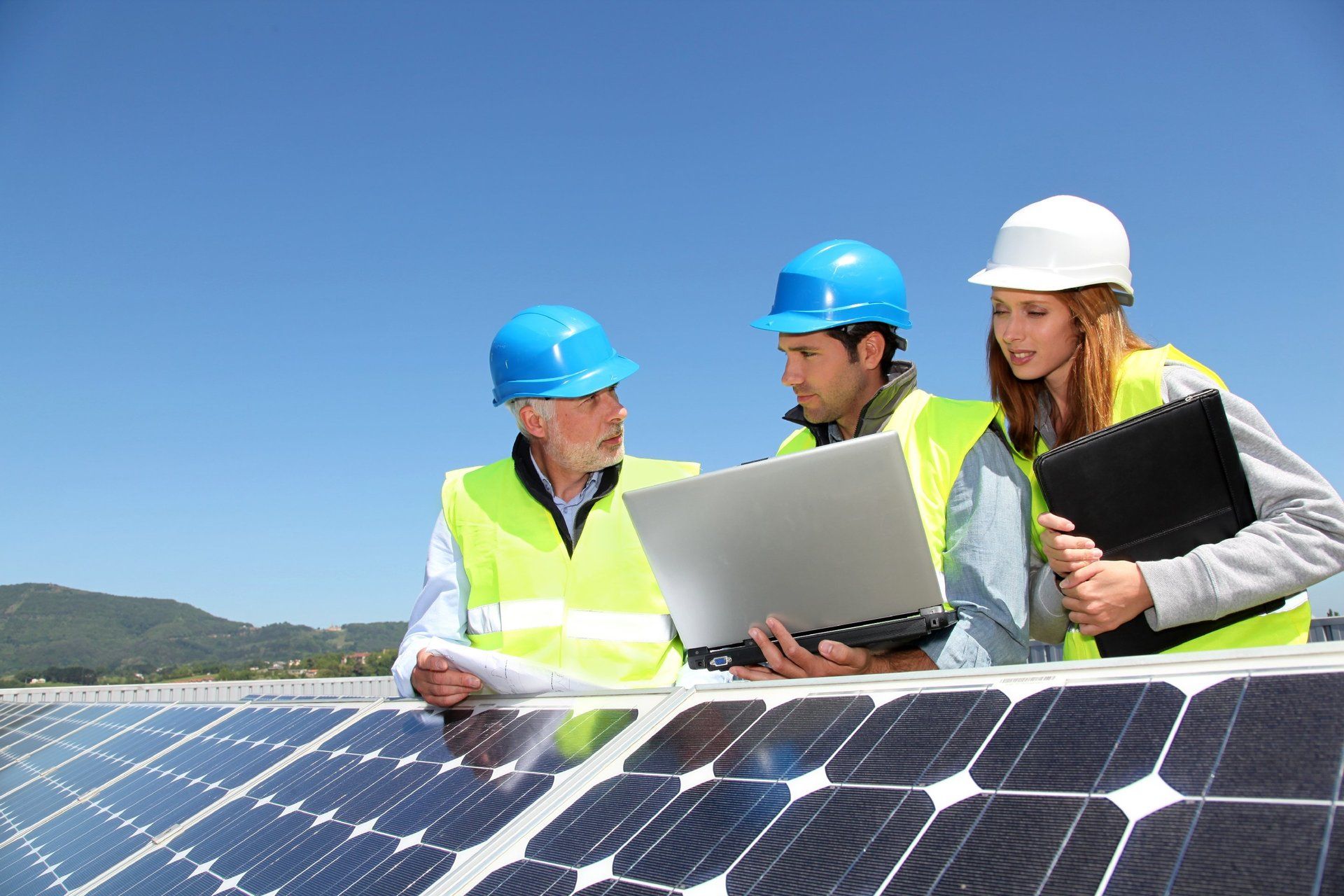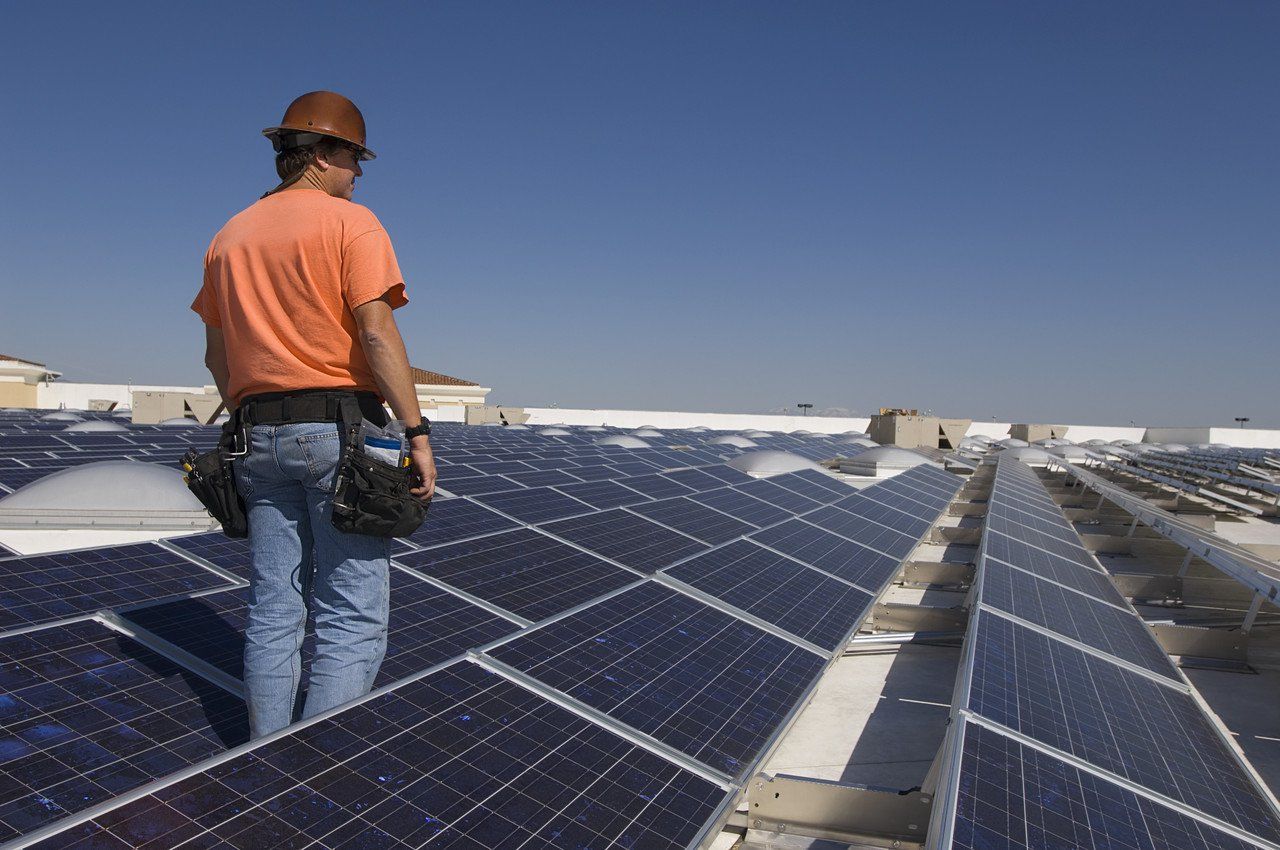Harnessing the Power of the Sun: Solar Energy on Warehouses in 2024
Key aspects of the solar landscape on warehouses in 2024
In 2024, the global push toward sustainable energy solutions has taken center stage, and one of the prominent players in this movement is the integration of solar power on warehouses. As the demand for eco-friendly practices continues to rise, businesses are increasingly turning to solar energy to not only reduce their carbon footprint but also to benefit from cost-effective and renewable energy sources.

Warehouses, with their expansive rooftops and ample space, are ideal candidates for solar installations. Here are some key aspects of the solar landscape on warehouses in 2024:
1. Cost Efficiency and Long-Term Savings:
Solar technology advancements and decreasing installation costs have made it more financially viable for warehouses to adopt solar solutions. In 2024, businesses are recognizing the long-term savings achieved through reduced energy bills and, in many cases, government incentives and tax credits for adopting renewable energy.
2. Technological Advancements:
Solar panel efficiency has seen significant improvements, allowing warehouses to generate more power even in areas with less sunlight. Additionally, the integration of smart technologies, such as advanced monitoring systems and predictive analytics, optimizes energy production and consumption, enhancing overall efficiency.
3. Sustainable Practices and Corporate Social Responsibility:
Embracing solar energy aligns with corporate social responsibility initiatives. Warehouses are actively seeking ways to reduce their environmental impact, and solar installations contribute to a positive public image and attract environmentally conscious partners and customers.
4. Grid Independence and Energy Resilience:
Solar-equipped warehouses have the advantage of being partially or fully independent from the traditional power grid. This not only provides energy resilience during power outages but also allows businesses to store excess energy, contributing to a more stable and reliable energy supply.
5. Environmental Benefits:
The transition to solar energy on warehouses significantly reduces greenhouse gas emissions, contributing to a cleaner environment. This aligns with global efforts to combat climate change and creates a positive impact on the surrounding communities.
6. Government Policies and Incentives:
Supportive government policies and incentives play a crucial role in the widespread adoption of solar on warehouses. In many regions, governments offer financial incentives, tax breaks, and streamlined permitting processes to encourage businesses to invest in renewable energy.
7. Integration with Energy Storage:
In 2024, energy storage solutions, such as advanced batteries, are seamlessly integrated with solar installations on warehouses. This allows businesses to store excess energy during peak production times and use it during periods of high demand or low sunlight, further optimizing energy usage.
As we venture into a more sustainable future, the synergy between warehouses and solar energy exemplifies how businesses can thrive economically while making substantial contributions to a greener planet. The adoption of solar technology on warehouses in 2024 reflects a growing commitment to environmental stewardship, cost efficiency, and long-term resilience.

In the modern era, where sustainability is paramount, and energy costs are on the rise, the utilization of battery storage systems has emerged as a game-changer. Comgen are able to supply different plant room battery storage solutions ranging from 100kWh to 250kWh. These systems offer a plethora of benefits that not only enhance energy efficiency but also contribute to a cleaner and more sustainable future. For commercial and industrial facilities, integrating battery storage into energy management strategies is proving to be a wise investment. Let's delve into the numerous advantages of embracing battery storage to manage energy usage. 1. Energy Independence One of the primary benefits of battery storage systems is the liberation they provide from traditional energy grids. By storing excess energy generated from renewable sources like solar panels or wind turbines, individuals and businesses can reduce their reliance on the grid. This independence not only offers peace of mind during power outages but also shields against fluctuating energy prices. If you are still fortunate enough to have a night time rate lower than the day time rate you would benefit further from the overnight storage of the cheaper energy to use during the working day. 2. Peak Shaving and Load Management Battery storage systems empower users to optimize their energy consumption by strategically discharging stored energy during peak demand periods. This process, known as peak shaving, helps to alleviate stress on the grid, ultimately reducing electricity costs. Moreover, by intelligently managing loads and deploying stored energy during high-demand intervals, users can avoid expensive peak-time tariffs imposed by utility companies. 3. Renewable Energy Integration The intermittent nature of renewable energy sources, such as solar and wind, presents a challenge for consistent energy supply. Battery storage systems serve as a buffer, bridging the gap between energy generation and consumption. They store surplus energy generated during periods of high production and release it when demand exceeds supply, ensuring a reliable and continuous power supply from renewable sources. 4. Cost Savings Implementing battery storage systems can lead to substantial cost savings over time. By reducing reliance on grid-supplied electricity during peak hours, users can lower their overall energy bills. Additionally, battery storage enables users to take advantage of time-of-use pricing models, purchasing electricity when rates are lowest and storing it for later use during peak periods when prices are higher. 5. Grid Stability and Resilience Battery storage systems play a crucial role in enhancing grid stability and resilience. They provide ancillary services like frequency regulation and voltage control, mitigating fluctuations caused by intermittent renewable energy sources or sudden changes in demand. In regions prone to natural disasters or grid failures, battery storage serves as a reliable backup power source, ensuring uninterrupted electricity supply for critical operations. Conclusion In conclusion, the benefits of utilizing battery storage systems to manage energy usage are undeniable. From enhancing energy independence and optimizing consumption to integrating renewable energy sources and promoting environmental sustainability, these systems offer a multitude of advantages for individuals, businesses, and communities alike. As technology continues to advance and costs decline, battery storage is poised to play an increasingly integral role in shaping the future of energy management and building a more resilient and sustainable world. #Batterystorage #renewableenergy #energyshaving #energymanagement #saveenergycosts #BESS #Batteryasaservice

In recent years, rooftop solar has emerged as a prominent player in the renewable energy landscape, offering individuals and businesses the opportunity to generate clean electricity right from their rooftops. However, amidst this surge in adoption, navigating Distributed Network Operator (DNO) applications and overcoming associated challenges remains a critical aspect of rooftop solar integration. We have notices recently more and more applications being returned with constraints or refused. The market is waking up to rooftop solar and the PPA model and the more companies that adopt it will have further impact on DNO applications, much like we have seen in the larger ground mounted market. We felt it is important to make people aware of this and share some insight to consider. DNO applications serve as the gateway for connecting rooftop solar systems to the grid. Whether it's residential or commercial installations, understanding the intricacies of DNO requirements and processes is crucial for ensuring a smooth transition to solar energy. From paperwork to technical specifications, thorough preparation is essential to expedite the application process and avoid potential delays. Addressing Technical Hurdles: Rooftop solar installations present unique technical challenges for DNOs, ranging from voltage regulation to grid stability. As solar penetration increases, these challenges become more pronounced, requiring innovative solutions to maintain grid reliability. Collaborative efforts between solar installers, DNOs, and regulatory bodies are necessary to address technical hurdles effectively. Smart inverters, advanced monitoring systems, and energy storage solutions emerge as key technologies in mitigating grid-related issues and optimizing solar integration. Mitigating Grid Constraints: Grid congestion is a growing concern as rooftop solar installations proliferate. To alleviate congestion and optimize energy flow, strategies such as demand-side management, grid modernization, and localized energy trading platforms are gaining traction. By leveraging these solutions, we can maximize the benefits of rooftop solar while minimizing its impact on grid stability. Navigating Regulatory Landscape: The regulatory landscape surrounding rooftop solar varies across regions, impacting DNO applications and installation processes. Clear and supportive policies are essential for fostering a conducive environment for solar expansion. Advocacy efforts aimed at streamlining regulations and incentivizing rooftop solar adoption can accelerate the transition to clean energy. Embracing Sustainability: Beyond its environmental benefits, rooftop solar empowers communities, fostering energy independence and resilience. By embracing rooftop solar and addressing DNO-related challenges, we not only reduce carbon emissions but also pave the way towards a more sustainable and equitable energy future. In conclusion, navigating DNO applications and addressing associated challenges is crucial for unlocking the full potential of rooftop solar. Collaboration, innovation, and advocacy are key in overcoming barriers and accelerating the transition to clean, renewable energy. Together, we can build a brighter, more sustainable future powered by rooftop solar.

The purpose of this post is to answer one of the common questions we get asked about from a capex perspective. We aim to provide an analysis of the costs associated with maintaining a solar system and to propose effective strategies for budget management. As we strive to embrace sustainable energy solutions, it is crucial to ensure the financial viability and efficiency of any solar infrastructure. Solar System Overview: A solar system, comprising of a 500kWh capacity, would be instrumental in reducing a substantial carbon footprint and lowering energy costs. However, with the benefits come ongoing operational and maintenance expenses that must be carefully managed. Maintenance Costs Breakdown: A. Routine Inspections and Cleaning: Regular inspections and cleaning are essential to maximize the efficiency of solar panels. Costs associated with professional cleaning services, as well as periodic inspections, should be factored into the budget. B. Equipment Maintenance: Solar inverters, batteries, and other components require routine maintenance to ensure optimal performance and longevity. Budget considerations should include costs for spare parts, repairs, and scheduled equipment checks. C. Monitoring and Control Systems: Investing in an effective monitoring system is crucial for detecting any anomalies promptly. Subscription fees, software updates, and potential hardware replacements should be considered. D. Personnel Training: Ensuring that our staff is well-trained in solar system management contributes to cost-effective operations. Budgetary provisions for training programs and certifications should be included. E. Warranty and Insurance: Ongoing warranty fees and insurance premiums safeguard against unforeseen events, providing financial protection for system repairs or replacements. Budget Management Strategies: A. Prioritize Preventive Maintenance: Emphasize routine inspections and preventive maintenance to identify and address potential issues before they escalate, minimizing downtime and repair costs. B. Utilize Predictive Analytics: Implement predictive analytics and monitoring tools to anticipate potential failures, allowing for proactive intervention and reducing overall maintenance costs. C. Explore Energy Storage Solutions: Investigate the feasibility of integrating energy storage solutions to optimize energy usage, enhance grid independence, and potentially reduce demand charges. D. Evaluate Technology Upgrades: Assess the potential benefits of upgrading to newer, more efficient solar technologies that may offer improved performance and lower long-term maintenance costs. E. Negotiate Service Contracts: Negotiate service contracts with reputable maintenance providers to ensure cost predictability and access to timely support. Conclusion: In conclusion, the maintenance of a large solar system is a critical aspect of commitment to sustainable energy practices. By strategically managing the associated costs and implementing efficient budgetary measures, we can ensure the long-term success and financial viability of a solar infrastructure. We fully understand the importance of the operation and maintenance of a PV system. As a Power Purchase Agreement (PPA) Funder it is imperative in our strategy to maximise the panel efficiency and reduce any downtime of the site. This in turn adds the most value to us and to our clients who are considering a solar installation but are unable to manage the budgeting needed to maintain a system which can be Thousands of pounds per annum. It is important to note that via our PPA model we take on all operating and maintenance expenses as part of the arrangement so all our clients need to worry about is the reduced energy bill! To learn more or request further information on how to budget for solar maintenance head to our website www.comgensolar.com or book a call a call with us here https://calendly.com/comgen/15-minute-exploratory-call. #Sustainability #SolarPower #BudgetManagement #RenewableEnergy #CleanEnergy #SolarMaintenance #GreenTech #EnergyEfficiency #ClimateAction #SolarInnovation #EcoFriendlyLiving #solarinstallation #solarinstallers #commercialsolar #ppa #ppafunding

Introduction: In an era where sustainability meets fiscal prudence, asset managers are strategically leveraging Commercial Solar Power Purchase Agreements (PPAs) to bolster their portfolios. This comprehensive guide sheds light on the tangible SEO-targeted benefits that asset managers can accrue by embracing Commercial Solar PPAs. I. Cost-Effective Solutions for Asset Managers: Zero Upfront Investment: Commercial Solar PPAs empower asset managers with solar solutions sans the hefty upfront costs, redirecting capital to other pivotal investment avenues. Budget Predictability through Fixed Rates: Enjoy the stability of fixed or predictable rates over extended terms, shielding asset managers from the uncertainties of conventional energy markets. Sustainable Long-term Cost Reduction: Lock in favorable rates for 10-20 years, ensuring enduring cost savings that outshine traditional utility expenditures. II. SEO-Optimized Environmental Stewardship: Green Energy Leadership: Elevate your portfolio's environmental profile with a focus on commercial solar PPAs, showcasing a commitment to sustainable, eco-friendly practices. Regulatory Compliance Excellence: Navigate evolving sustainability standards effortlessly, positioning asset managers as leaders in adherence to global green energy regulations. CSR Excellence through Solar Innovation: Enhance corporate social responsibility (CSR) initiatives by adopting commercial solar PPAs, signaling commitment to a green future and fostering positive brand perception. III. Mitigating Risks for Asset Managers: Energy Price Stability: Hedge against market volatility with fixed rates, minimizing financial risks tied to energy procurement for asset managers. Grid-Independence Advantage: Bolster operational resilience by decreasing dependence on traditional grids through on-site or remote solar energy generation. IV. Asset Value Boost with Commercial Solar PPAs: Elevated Property Values: Commercial properties featuring solar installations command a premium, enhancing asset value for forward-thinking asset managers. Diversified Revenue Opportunities: Beyond cost savings, commercial solar PPAs open doors to additional revenue streams through potential surplus energy sales to the grid. Conclusion: In the dynamic landscape of commercial asset management, integrating SEO-optimized Commercial Solar PPAs emerges as a strategic move. Beyond immediate financial gains, these agreements align seamlessly with environmentally conscious investment strategies, ensuring that asset managers stand out in the realm of sustainable and lucrative commercial solar investments. Explore the potential today for a greener, more profitable tomorrow. #SolarPower #RenewableEnergy #CommercialSolar #SustainabilityInFinance #GreenInvesting #SolarPPA #AssetManagement #CleanEnergyFuture #ClimateAction #GreenFinance

🌟 Enhance Property Value and EPC Rating: Investing in a solar installation for your commercial properties not only showcases your commitment to sustainability but also substantially boosts your Energy Performance Certificate (EPC) rating which as we all know has been affected by recent UK regulatory changes. This positions your properties as energy-efficient and eco-friendly, attracting environmentally conscious tenants and enhancing their market value. 📈 🌱 Optimize Your BREEAM Certification with Solar PPA: Explore the benefits of a solar Power Purchase Agreement (PPA) to achieve a higher BREEAM certification for your commercial assets. A solar PPA not only demonstrates your dedication to environmental responsibility but also provides a financially savvy solution, contributing to a greener and more sustainable business model. 🌎💼 📊 Unlock Financial Advantages with Commercial Solar PPA: Discover the financial benefits of adopting a commercial solar PPA. Lower energy costs and government incentives not only make your properties more appealing to tenants but also showcase your commitment to renewable energy practices, adding value to your commercial property portfolio. 💰☀️ 🌐 Future-Proof Your Commercial Investments: Stay ahead in the market by future-proofing your commercial properties with solar solutions. In an era where sustainability is key, properties equipped with solar installations and PPAs stand out, attracting businesses and tenants looking for forward-thinking, energy-efficient spaces. 🏢🌟 🔧 Tailored Solar Solutions for Your Portfolio: Ready to explore the potential of solar for your commercial properties? Email us, hello@comgensolar.com to discuss customized solar installation options and PPAs that can optimize your EPC rating and BREEAM certification. Future-ready commercial properties start with solar! 🌞🔗 #CommercialRealEstate #SolarForBusiness #SolarInvestment #EPCRating #BREEAMCertification #SustainableProperties #GreenBuilding #RenewableEnergy #SolarPPA #EnergyEfficiency #PropertyOwners #FutureReady #solarinstallation #warehousesolutions

🏢 Site Assessment: Understand your building's solar potential. Factors like location, orientation, and available space impact energy generation. Engage experts like us for a comprehensive site analysis. ⚡ Energy Consumption Analysis: Dive deep into your energy usage patterns. Assess historical data to determine the optimal solar capacity needed to meet your business demands. Precision is key! This is most commonly understood using Half Hourly Data (HHD) if you have a smart meter. 💲 Financial ROI Projections: Crunch the numbers for a crystal-clear financial picture. Evaluate potential savings, and calculate the Return on Investment over the PPA term if you are considering purchasing it back at any point. It's about ensuring sustainability makes financial sense. 🌐 Government Incentives Exploration: Uncover available incentives, tax credits, and rebates. Governments often incentivize renewable energy adoption, making your PPA investment even more attractive. 🔧 Technical Viability: Ensure technical compatibility between your site and the proposed solar system. Factors like roof condition, structural integrity, and interconnection feasibility are crucial. As PPA funders we are happy to support your business with factoring in civil costs and potentially roof replacements or repair costs which can be factored into the PPA price. Ready to embark on your solar PPA journey? 🌞 Reach out and arrange a free feasibility report to understand the full potential of sustainable and cost-effective energy solutions. 💬⚙️

Comgen have been working with commercial property owners across the UK to unlock the potential of their roof space via our unique fully funded PPA model. A PPA (Power Purchase Agreement) is a contract that we undertake with the energy user to purchase the power we produce via the solar system at a fixed, market discounted rate.
NO upfront costs, NO debt and you can typically halve your electricity bills
We provide a FREE feasibility study, which would enable us to determine how much energy can be produced. We then calculate the price per kW and work out your monthly savings. The feasibility study also considers the positive environmental impacts including; EPC ratings, CO2 emission savings and sustainability metrics.

Many companies commit to solar installations to reduce CO2 and reduce their energy bills but what most do that you won't know is they don't use their own money, they use ours! Our PPA Solution can be seen as 0% finance without the debt on your books to buy back the system down the line.
We are commonly asked how this looks financially so the table and chart below visualizes the net cost to purchase back the system at up to 10 years into the agreement. The system cost will never be at a premium so by taking into account assumed savings per install size vs value we can calculate the relative net cost to buy the system. In all scenarios, at year 5 the system becomes essentially 'free' and there positive in cash flow for the remainder of the PPA.

This nuclear parts manufacturer was using a huge amount of energy and as much as the roof space limited the overall system size vs usage we were still able to save them over £20,000 and positively impact their carbon emissions.
This recycling centre was actually capped on their energy usage and was unable to draw any more electricity from the grid. This was a real problem for them as with the commitment to service more customers and a large investment in 'on site' machinery they needed to find the extra power to meet requirements. The PV system was the perfect solution to extra energy and we was able to save them almost £23,000 per annum on their bills
